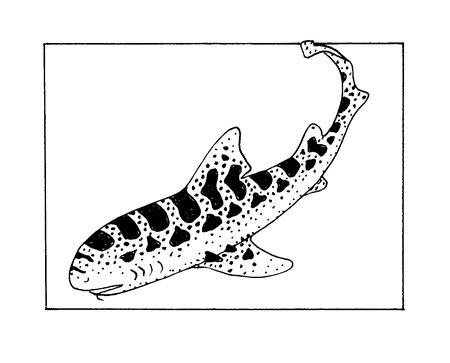Leopard Sharks Inhabit Laguna

With a range along the coast from Oregon to the Gulf of California, the leopard shark (Triakis semifasciata) is common along Laguna’s coastline. Often found in shallow inshore waters of rocks, sand, kelp beds and muddy estuaries, it’s mostly seen in warm waters of one to 10 feet. The sleek shark has an elongated body and cruises in an undulating manner just above the bottom. Colored gray with a bronze tinge, they are covered with distinctive black spots, saddle markings and bars that are unique to each shark and analogous to fingerprints in humans. It has a large triangular dorsal fin (the classic shark top fin) with a large second dorsal fin near the tail. The snout is blunt and rounded. The eyes are near the top of the head and it has the asymmetrical tail found on many species of sharks. A member of the Houndshark family, it can reach a maximum length of seven feet and has an average lifespan of 25 to 30 years.

Although scientists believe the species might be nomadic, they have found that populations from Oregon to Southern California to the Gulf of California exhibit significant differences in their genetic makeup due to the lack of intermingling of populations. In fact, they have identified at least seven distinct gene pools along the coast of California with the Humboldt Bay population being the most distinct. This implies that populations tend to stay resident to specific territories. In certain seasons, locations such as La Jolla Shores in San Diego, the Elkhorn Slough in Monterey Bay and on a more limited basis, Laguna Beach, the adults will form large schools segregated by sex.
Leopard sharks are slow growing and reach sexual maturity at around 10 years of age. Reproducing annually, the sharks are ovoviviparous, with the eggs fertilized and gestated internally. While pregnant, the females tend to remain in warmer waters as the eggs develop. Ten to 12 months later, generally in the months of April and May, the eggs hatch inside the mother before the seven-inch long pups emerge fully-formed into the ocean. A single litter can number up to 37 pups. Pups usually congregate in large numbers in eelgrass and shallow waters just off shore during the summer and fall before departing. The shark’s diet is primarily benthic (living on or near the bottom of the ocean) invertebrates (i.e. crab, shrimp and clams). As they age, their diets become opportunistic and include bony fish (i.e. anchovies), cartilaginous fish (i.e. rays, other sharks) and octopus.
Predators of adult leopard sharks include great white sharks, sevengill sharks and other larger fish as well as recreational anglers. Marine mammals prey on juveniles. In addition, there is some concern about habitat loss due to urban development and pollution in the bays and estuaries that serve as their nurseries as well as the number of juveniles that are being taken for the aquarium trade. However, the sharks are currently not listed on any vulnerable or endangered species list. Unaggressive and quick to escape if encountered, they are not known to pose any threat to humans. During the summer in Laguna, individual juveniles can be commonly seen inside the shore break in less than two feet of water and groups of juveniles can often be seen swimming above eel grass by the rocks. It is not unusual and quite thrilling to encounter adult individuals while snorkeling in shallow waters above the rocks and occasionally finding groups of 20 or more adults congregating in certain coves in Laguna Beach.
Residents and year-round ocean swimmers, Mia Davidson and artist Jan Sattler are dedicated to fostering stewardship of Laguna’s coastal ecosystems.




